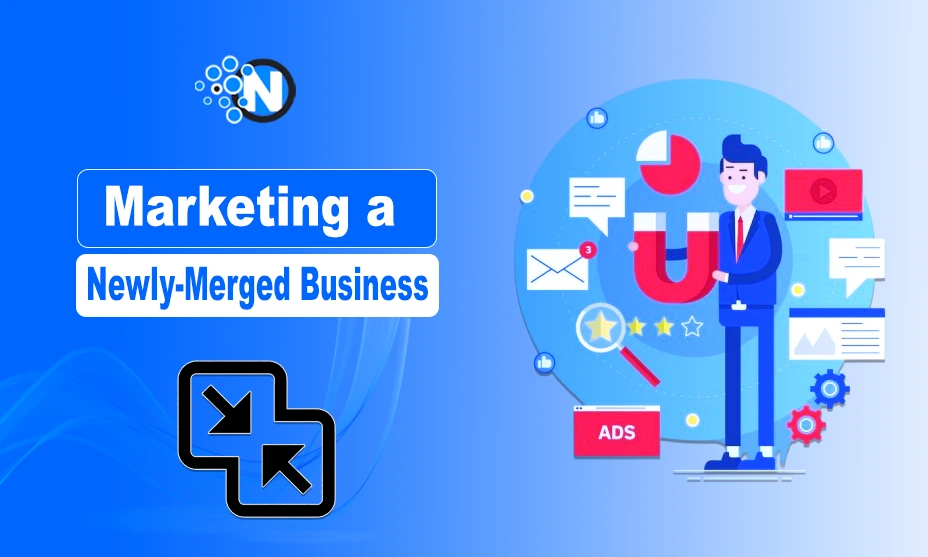Marketing a Newly-Merged Business: 10 Pro Tips

Numbers show that worldwide transactions involving different organizations reached a value of around $2.5 trillion, with the United States taking over half of that total. This high level of activity isn’t a surprise because many see these deals as a big chance for growth and fresh ideas.
However, the stakes are high. Experts often say that 70% to 90% of these deals fall flat, with lackluster marketing integration cited as a major factor. If a newly-merged business fumbles its branding or messaging, customers might get confused or even jump for a competitor.
To help you keep your newly joined entity on the right track, I have listed 10 practical tips for marketing a newly merged business that can increase your chances of success.
Let’s start!
10 Tips for Marketing a Newly-Merged Business

1. Make Marketing a Priority From Day One
Once an acquisition or merger is signed, it’s easy to focus on financials and legal formalities, leaving marketing for later. That is a mistake. By lining up your marketing plan early, you set the tone for how internal teams and outside audiences see the new business arrangement. Any gap in branding or communication is a chance for confusion to take root.
If you get your messaging ready right away, through consistent brand updates, social posts, and press releases, you’ll reassure existing customers and give prospective ones a clear view of what’s to come. Don’t be afraid to call for help. Sometimes, mergers and acquisitions require outside expertise to ensure transitions are handled with care.
Experts who handle these deals know how to bring businesses together with precision, ensuring every acquisition is handled smoothly and strategically for long-term growth. Merger and acquisition (M&A) companies that support businesses during this time make integration seamless by handling details like contract negotiation, escrow management, and outreach services so that businesses can focus on updating their audience.
A well-executed merger isn’t just about the legal and financial details, it’s also about ensuring the brand remains strong in the market. Without the right marketing strategy, even the smoothest acquisition can leave customers uncertain. That’s why it’s crucial to align branding, messaging, and customer communication from day one.
2. Preserve the Core Brand Feel
Another big hurdle after a combination is figuring out how to keep the target company’s original spark. Loyal supporters often worry that an ownership switch will ruin what they love about the business. The best way to solve this concern is by digging into why customers liked that brand in the first place. Was it their pricing, a unique product style, or a promise of privacy? Keep those benefits intact, and show buyers that you’re not about to discard their favorite features.
3. Communicate Changes Right Away
Shifting ownership can raise eyebrows among customers, employees, and suppliers. Don’t let rumors or concerns shape the narrative. Jump in early with transparent announcements, social messages, and press releases to explain the next steps. If there’s a better deal for customers, like improved pricing or a bigger product selection, make sure they know. Quick and honest communication can soften any jitters and set a positive tone for what’s ahead.
4. Protect Brand Loyalty
When one business joins with another, some folks assume the original brand will vanish. That’s risky if that brand has a dedicated fan base. Before you start making changes to logos or slogans, ask: which elements do people cherish? By preserving the best parts, you’re telling current customers that you value their loyalty. The result is more trust and a smoother path to keeping them on board.
5. Update Your Branding Approach Carefully
For businesses that need a fresh identity, a merger or acquisition can be the perfect time to do it. Maybe the previous branding wasn’t great, or you’re introducing an upgraded service that calls for a new design. Either way, be direct about why this new look is a step up for consumers. Tie the marketing updates to real customer benefits like: quicker service, more product options, or a stronger sense of reliability.
6. Refresh Your Customer Segments
When two organizations combine, the overall audience might expand or shift. You could discover new consumer groups you never targeted before. Spend time figuring out these fresh segments and how your combined offerings match their needs. Customize your outreach through social ads or email campaigns to address each group’s interests. By zeroing in on different pockets of buyers, you can boost revenue and spread the word about your newly merged brand more effectively.
7. Keep Your Internal Teams in Sync
Even the best marketing plan will falter if your internal teams aren’t on the same page. Sales, customer service, and operational departments should all be informed about brand updates and messaging. Hold regular check-ins to make sure everyone understands how the business transformation affects day-to-day tasks. This approach helps create a united voice, so the public hears consistent information whether they’re on a sales call or scrolling through your social feed.
8. Set a Bigger Marketing Budget
A post-merger rebrand might sound intimidating, but it usually requires extra funds for ads, design, or user outreach. If you plan to make a real splash, don’t skimp on marketing. A strong advertising push coupled with the correct content marketing strategy right after the combination can help audiences understand what’s new, what’s the same, and why they should stick around. That might include sponsored posts on social platforms, a refreshed website, or in-person events—whatever suits your target audience best.
9. Engage in Public Relations
The success of a newly merged company depends much on public relations. Start with releasing carefully written press releases announcing the merger to important media sources to boost your PR initiatives. These press releases should emphasize the strategic justification for the merger, list the advantages for stakeholders and consumers, and offer comprehensive details on the united company.
10. Track Results and Be Flexible
After the dust settles, it’s tempting to overlook the behind-the-scenes details of your new marketing plan. That can be a huge slip-up. Keep tabs on key metrics like customer retention, social engagement, or overall sales growth. If you spot any red flags, like a dip in repeat buyers or complaints about your updated services, don’t ignore them.
Adjust your approach, tweak your messaging, and stay ready to pivot as soon as you see an issue. Your willingness to refine your marketing strategy can mean the difference between a strong, enduring brand and a costly misstep.
Final Words
Merging two businesses can be a complex process, but effective marketing can help ensure a smooth transition and successful integration. Marketing a newly merged business requires careful planning and execution. With the above-mentioned tips, you can effectively complete the marketing process and position your business for success.




